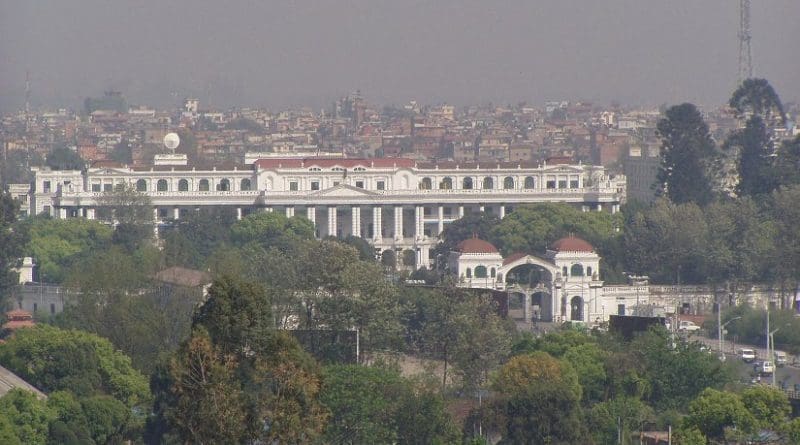Nepal: The Grand Leftist Alliance And Its Aftershocks – Analysis
By SAAG
By Dr. S. Chandrasekharan
The Grand Leftist Alliance forged on October 3 by the two major Communist Parties and the newly formed Naya Shakti of Baburam Bhattarai took the political circles by surprise.
In the just concluded local body elections, the two parties- UML and the Maoist Centre fought bitterly with no holds barred in most of the constituencies and yet soon after the conclusion of the last group of elections in province number 2, the two joined together to form the alliance and thus pushing the democratic forces into a “panic mode.”
Soon after the announcement of the alliance, the analysts were quick to point out, a possible emergence of a two party system, a communist government for the next decade, expectation of continued political stability etc. But the ground realities could be different and may not translate mathematically at the higher level elections as the local bodies elections were fought in many areas on local issues only.
The conclusions made by the analysts were based on the number of votes obtained by each party in the local body elections and with the forthcoming alliances, the figures were extrapolated to the provincial and national levels. Though this method may be the only available tool to project for national elections, it looks to be very imperfect as so many other parameters will come into play- like the popularity of the candidates, the issues involved at the national and provincial levels as well as economic development etc.
First the Left Alliance: The Left Alliance is likely to be dominated by the UML that had secured over 14097 seats- a creditable achievement indeed and the Maoist Centre cannot but play a secondary role- a role that may not be liked by many Maoist cadres who fought the bitter civil war to occupy the leftist space in the country. Already the third group – the smaller Naya Shakthi has withdrawn from the alliance over the selection of a candidate for Gorkha 2 which Baburam Bhattarai had been claiming. He said that the alliance had barred him from contesting from that constituency though he belongs to that place.
Gorkha constituency is a typical case where the results of the local body elections cannot be mathematically transposed to the national level. Here both the UML and the Maoist centre scored well and candidates of Bhattarai group came a poor third. But if Bhattarai is to stand for elections in the same constituency, it will not be the same and he would have a fair chance of winning. Bhattarai, now within a few days of the alliance sees a break up of the alliance soon after the elections.
The Nepali Congress is also finding it hard to forge a “democratic alliance” with other minor parties. As one analyst had said that if the Nepali Congress is to give in to the demands of other parties in seat sharing, it will be left hardly with any seat. The FSF-N and the RJP of the Madhesi groups are demanding 35 percent of the parliamentary seats and 40 percent of the provincial seats in the first past the post system. 35 percent comes to 58 out of a total of 165 seats and 40 percent comes to 132 of the 330 provincial seats. This is certainly too big a demand unworthy of any consideration.
The Madhesi groups are demanding such a high proportion on two counts- one on the basis of the population and two on the basis of the votes obtained in the recent local body elections. Here again the arithmetic does not work in the same orderly way!
The Madhesi groups never remained together except during agitation times. Look at the way both Hridayesh Tripathi of Bhairava and Brijesh Kumar Gupta ditched the Madhesi cause and joined party that has consistently worked against the interest of the Madhesis. Gachhadhar who continued to become the Dy. Prime Minister in any dispensation merged his party (not joined) with the Nepali Congress only to keep his hopes alive of another shot at the post of a Deputy Prime Minister!
There is a feeling amongst the Madhesi circles is that while Madhesi parties can go it alone the Nepali Congress cannot do without it. This is not a proper assessment of their chances. They should know that the Nepali Congress was the most successful party in the just concluded local body elections in Province No. 2. If their aim is to get the democratic forces together and prevent a landslide victory of the leftists, they will have no choice but to forge an alliance with the Nepali Congress. I have said before and would reiterate that there is a lot of goodwill for the Nepali Congress even in Terai. The Madhesi groups will be better off in an alliance with the Nepali Congress than with any other party.
To conclude, the fears that Nepal is hurtling towards a quasi one party system or a polarised two party system in the near future is not well founded and it is too early to make such assessments. There is still time for the Madhesi groups to make amends and join the main democratic forces for the purpose of the provincial and national level elections thus providing stability to the country.

